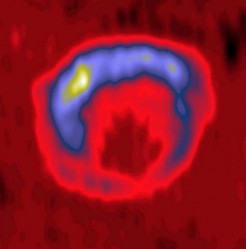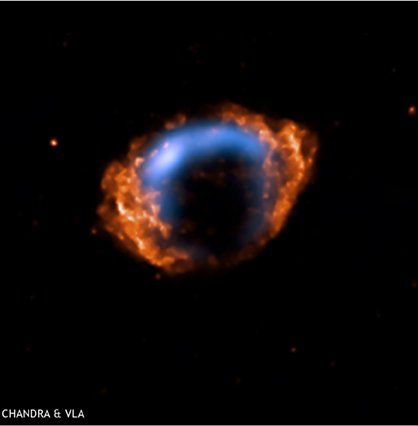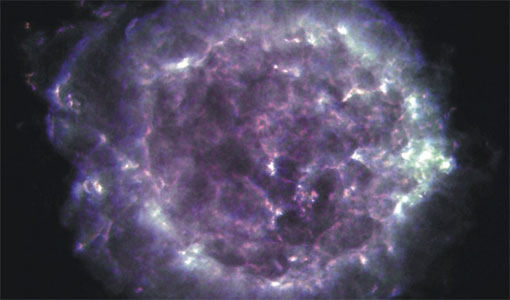Astronomers have found the remains of the youngest supernova, or exploded star, in the Milky Way Galaxy. The supernova occurred in 1868, but was hidden behind a thick veil of gas and dust. Using the Very Large Array (VLA) and NASA’s Chandra X-Ray Observatory, which could peer through the veil, astronomers have now found “G1.9+0.3,” the first example of what scientists believe are a “missing population” of young supernova remnants. This is NASA’s long awaited announcement, and astronomers have been searching for over 50 years for this type of young supernova.
From observing supernovae in other galaxies, astronomers estimate that about three such stellar explosions should occur in our Milky Way every century. However, the most recent one known until now occurred around 1680, creating the remnant called Cassiopeia A. The newly-discovered object is the remnant of an explosion only about 140 years ago.
“It’s great to finally track one of them down,” said David Green of the University of Cambridge in the UK, who led the VLA study.
Supernovas mark the violent death of a star, and release tremendous amounts of energy and spew heavy elements such as calcium and iron into interstellar space. This seeds the clouds of gas and dust from which new stars and planets are formed.
The lack of evidence for young supernova remnants in the Milky Way had caused astronomers to wonder if our Galaxy, which appears otherwise normal, differed in some unknown way from others, or if our understanding of the relationship between supernovae and other galactic processes was in error.
Cassiopeia A supernova remnant — from the year 1680.
The astronomers made their discovery by measuring the expansion of the debris from the star’s explosion. They did this by comparing images of G1.9+0.3, made more than two decades apart.
In 1985, astronomers led by Green observed G1.9+0.3 with the VLA and identified it as a supernova remnant. At that time, they estimated its age as between 400 and 1,000 years. It is near the center of our Galaxy, roughly 25,000 light-years from Earth.

In 2007, another team of astronomers, led by Stephen Reynolds of North Carolina State University, observed the object with the Chandra X-Ray Observatory. To their surprise, their image showed
the object to be about 16 percent larger than in the 1985 VLA image.
“This is a huge difference. It means the explosion debris is expanding very quickly, which in turn means the object is much younger than we originally thought,” Reynolds explained.
However, this expansion measurement came from comparing a radio image to an X-ray image.
To make an “apples to apples” comparison, the scientists sought and were quickly granted observing time on the VLA which confirmed the supernova remnant’s rapid expansion.
The object already has provided surprises. The velocities of its explosion debris and extreme energies of its particles are unprecedented. “No other object in the Galaxy has properties like this,” said Reynolds. “Finding G1.9+0.3 is extremely important for learning more about how some stars explode and what happens in the aftermath.”
Original News Sources: Chandra site , National Radio Astronomy Observatory



Yep. Just as I thought. Yet another N.A.S.A. let down. haha. I knew it was not going to be anything big, so I didnt lose any sleep over it. I figured it was just another puff of dust in a cloud somewhere in space.
You people didnt really expect N.A.S.A. to have anything amazing to say did you?
They dont do nothing but gaze at space dust, specks of light, dream up an idea of whats going on, then hype everyone up with something like this on line.
The extent of their space program has been nothing more then a flying can around the edge of the Earths atmosphere a few laps then crash land almost in the desert or ocean.
Once apon a time, they sent a few tuna cans with people packed in them, to the moon for a few hours.
Soon there will be less then that in 2010. Sence then, N.A.S.A. has been nothing more then the same old general run of the mill, mundain dust puff chasers as always.
Makes fist and moves up and down. Seriously, they couldn’t release this information earlier? I guess it’s just not as great as what I and many others expected. Come on Webb telescope!
Woot.
Anticlimax !
Hmm…although interesting, the actual announcement was a letdown. If they keep this up, it’ll be like the little boy crying wolf.
I agree.
They just discovered a SNe which passed undetected at the moment of the explosion, which occurred ~140 years ago, because it was obscured by dust. Really interesting work. But I wouldn’t call it a “big announcement” and make the world to wait a whole week.
What are they going to do when a Population III star is discovered? Or direct imaging from the central BH is obtained? Or evidence of Dark Matter annihilation? etc. Make us to wait a year?
mmmmmm
Let’s go for a beer
MV
Why is there a 1 megabyte bitmap on this page?!
A SUPERNOVA?
Are you freaking kidding me? Really?
Here I was thinking we were on the brink of something worthy of at least a 2.5 out of 10 type of announcement for the general public and we get basically the equivalent of another “Britney Spears missed yet another court appearance…” blurb on page 15 of the local fish-wrap.
Way to get our hopes up NASA. Don’t announce anything until you find alien graffiti on the ass-end of the moon or proof that Cletus and Billy Joe were in fact abducted by aliens and subjected to various orifice probings.
Jerks. Freaking jerks.
What a complete letdown, while i agree that its interesting i can’t help but feel disappointed.
Here’s a late P.S. to my initial comment:
They were better off finding socks lost in the dryer.
So, finally got friends interested in science and now they’re going to think I’m crazy – this is not big news, NASA.
They were going to talk about a way to create stable, artificial wormholes, but the Kluthahfeljchjsedsians got to them first.
Well, that’s what I heard, anyway.
So much for the Event Horizon……………Clowns
Is the accepted date for Cas A 1640 or 1680? You have one in the text & the other in the caption.
Many expectation for this?????. Is only one better photo a new supernove, pisssssss
This is historic?.
The Nasa cientifics ay ay ay ay !!!
THATS IT ????????????????????
Mabye next they will find my tax dollars, oh wait they already did funding this cock of a project
uhhm, i think it is a lovely image.
I’m missing something… 3 supernovae per century in a 100k LY diameter galaxy – so we can expect to see ON AVERAGE 3 SN per century, but about 1/2 will be on other side of galactic core, and the rest will average 25k LY away behind dust and other stars?
I’m not surprised we’re not seeing them…
He he he…
And here I was thinking that “my” ESA was *the* PR disaster in the space industry…
He he he…
😀
What makes the whole thing even more ironic is that the scientific paper (Green et al.) was actually submitted to the Letters of the Monthly Notices of the Royal Astronomical Society (not Nature or Science, no ,no) on the 15th of APRIL and posted, back then, without any fanfare, on the arXiv preprint server here:
http://arxiv.org/abs/0804.2317
I had stumbled across this WEEKS ago already and thought it was very welcome and interesting news from the purely scientific point of view, but nothing to shake the normal public… (Definitely much less spectacular then the “naked-eye” GRB 080319B!)
I did wonder a bit about a missing press release. And I completely missed the original UT announcement of the upcoming big NASA PR 5 days ago. Even if I had read it, I propbably would NOT have thought of the young SN, as I too would have expected something MUCH more spectacular.
Therefore, I must join the chorus: Booh, NASA, what a wet firecracker!!!
i, for one, am satisfied with this news! its exciting to think about how recent this supernova is, in terms of our collective history. NASA could have said that this supernova occurred yesterday and i would feel the same happiness because i am so used to hearing “billions” or “millions” of years ago. great job NASA! you guys have my full support. every discovery is an important one.
for those of you nay-sayers…how is this NOT big news? they’ve been searching for this for over 50 years. they finally found this type. its a great achievement. all your negative opinions probably are a result of your active imaginations running wild. 🙂
It’s been a LONG time since there’s been an observed supernova in the Milky Way galaxy,
That said, still an anti-climax.
I must correct myself a little bit…
The paper I stumbled across was actually this one:
http://arxiv.org/abs/0803.1487
which was submitted to the Letters of the Astrophysical Journal (and posted on the arXiv) on the 10th of MARCH!!
It even states in the title that they found the youngest SNR in our galaxy.
So somehow this is… old news.
So how far is this supernova from us? Is it actually 25,000 light years? They originally thought it was that far but is that still the distance they are estimating its at?
If it is 25000 LY away, then doesnt that mean that the explosion actually happened, not 140 years ago, but 140+25000 years ago?
Los astrónomos encontraron los restos de la supernova más joven de la VÃa Láctea, nuestra galaxia. El estallido de la estrella o supernova tuvo lugar en 1868 pero estaba oculto tras una grueso velo de gas y polvo. […] Fuente: Nancy Atkinson para Universe Today.
NASA must be worried funding might be cut?
Yeah, this is a reasonably big announcement for physicists and astronomers, but not something I think the generally disinterested general public would get excited about.
Considering that probably 90% of the public have little or no idea of what a star even is, I would think that there would be maybe 0.1% or less of the public that had some idea of what a supernovae is.
It really is an impressive find though. It will provide an excellent laboratory for testing models of supernovae and many other aspects of physics such as plasma astrophysics and whatnot. Many interesting phenomena occur at the shock boundaries of supernovae, so it’ll be great to see what science comes out of this object in the future.
Maybe NASA need to realise that people just don’t give a s__t unless the announcement concerns either aliens, or something with a spooky and sinister name like dark energy, or dark matter, or ‘killer black hole’, or perhaps ‘mega-super-killer asteroid’.
I was right on my first guess! It WAS a more recent supernova discovery in this galaxy!! It’s in plain print, just go back to the article with all the guesses, you’ll see!
I wish it had been my second guess though, imaging the accretion disk on Cygnus X-1, that would have been a MUCH bigger boost to astronomy!
My thanks go out to Don Alexander for his links to these original papers @ arXiv.org. I too came across these when they came out, and while interesting enough to save to disk, nothing worthy of the press buildup. Great papers on a little studied SNR, though .
Question! Where is the location of Cassiopeia A supernova remnant?
Whoooo! Go scientists! 🙂
So NASA found some advertising for Firefox. Well done.
I was hoping somebody would answer Alex Diamond’s question. Is the 1868 date the time when the light from the beginning of the supernova would have first reached the earth, 25,000 years after the event?
According to Wikipedia’s article on “G1 .9+.3” Alex Diamond is right on the money. The supernova happened over 25,000 years ago.
Well… now that was DEEE-pressing!
A big announcement of 50 years in the making would be actual water on Mars or proof of life SOMEWHERE!
What will they call an actual discovery of life when we find it?? A Jumbo announcement?
I was all excited, got my WIFE all excited about Space stuff for a change……… Now I have to hope she forgets I mentioned it and never have to tell her what they thought was big.
I’d rather not get THAT tone of eye, if you know what I mean 🙂
Wouldn’t the time frame of actual supernova explosion be exactly 25 thousand one hundred and forty years ago- ISH????
This is the most incredible news ever!!! I’ve always thought that supernovae don’t ever happen in our galaxy. Finally my dreams have come true. And yes I’m not being sarcastic!